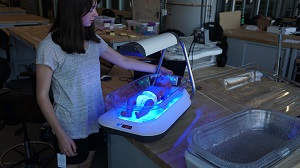By Haily Jones
Health care issues affect us on a global level, however getting 120 countries to agree on what is important on how to solve these problems can be nearly impossible. In many cases, the shocking reality is that many global health issues present in developing countries have already been solved in the U.S.
There are a number of reasons why U.S. solutions are not used on a global level, and many of the reasons resolve around cost, accessibility, and infrastructure differences. Design that Matters doesn’t view those issues as an excuse not to help, but as an opportunity to alter existing technologies; ones to support global health problems in developing countries to fit every country’s need. Ultimately, adaptability is the answer.
 Design that Matters is a nonprofit design company founded in 2001 by Timothy Prestero and a team of MIT students. This organization partners with professional and volunteer social entrepreneurs and designers to create products that solve problems that address basic needs. The organization collaborates with donors and partners, researching basic needs and testing technologies to benefit millions by offering quality services through adapted technology.
Design that Matters is a nonprofit design company founded in 2001 by Timothy Prestero and a team of MIT students. This organization partners with professional and volunteer social entrepreneurs and designers to create products that solve problems that address basic needs. The organization collaborates with donors and partners, researching basic needs and testing technologies to benefit millions by offering quality services through adapted technology.
At the beginning of each process, embedded assumptions about design are discussed. These assumptions take into account the environment, users, and conditions in which these technologies will be used. These assumptions must be addressed for the design to work. In many cases, the medical devices that exist to treat conditions are aiming at the wrong target and they do not work within the needed environment.
 When developing technologies, Design that Matters considers what issues poor, developing countries face and see if there is already a solution to the problem. They then take that adaptability approach to see how they can impact developing countries daily health related issues. The technology exists, but Design that Matters makes it their mission to acclimate these technologies so that users can get as much benefit as possible.
When developing technologies, Design that Matters considers what issues poor, developing countries face and see if there is already a solution to the problem. They then take that adaptability approach to see how they can impact developing countries daily health related issues. The technology exists, but Design that Matters makes it their mission to acclimate these technologies so that users can get as much benefit as possible.
Once such instance, that Design that Matters looked into, involves finding adaptable solutions for jaundice, a liver condition that affects 2/3 of the world population. Jaundice harms 5-10% of all newborns worldwide. Babies who are not quickly and properly treated can develop disabilities or can even die. While jaundice has detrimental effects on the world’s population, Design that Matters found the cure was so simple: shine blue light on a baby’s skin. Even when a country knows that blue light can prevent the disease, many don’t properly treat, often resorting to one light shining over several babies. The organization design the Firefly, a newborn phototherapy device, specifically to allow rural hospitals with limitations to successfully treat jaundice.
 Design that Matters adapted an existing treatment to create the Firefly, which in itself prevents incorrect use. Designers were aware that technology for treatment existed, and created this design so that all who use it are treated properly. While many countries will use one light to treat several newborns, the Firefly’s transparent bassinet has one light system attached per bed, where only one baby can fit inside. With proper adaptation and design, babies with severe jaundice are properly treated and able to get out of the hospital an entire day early. The Firefly is currently in 21 counties and has treated 60-70,000 newborns and makes desired health outcomes possible in developing countries.
Design that Matters adapted an existing treatment to create the Firefly, which in itself prevents incorrect use. Designers were aware that technology for treatment existed, and created this design so that all who use it are treated properly. While many countries will use one light to treat several newborns, the Firefly’s transparent bassinet has one light system attached per bed, where only one baby can fit inside. With proper adaptation and design, babies with severe jaundice are properly treated and able to get out of the hospital an entire day early. The Firefly is currently in 21 counties and has treated 60-70,000 newborns and makes desired health outcomes possible in developing countries.
With a successful phototherapy device, Design that Matters is setting itself up to create adjacent innovations to support the Firefly. Again, this organization looks into existing technologies to make adjustments for more beneficial use. An issue in many neonatal intensive care units is air conditioning that could lead to hypothermia among newborns. Otter, a warming device, is compatible with Firefly; and it will eliminate the risk of hypothermia by supplying a steadying warming to babies in these bassinets. Another concern Design that Matters hopes to address is to report errors in equipment digitally. With the Echo, equipment sends messages to technicians so they know the exact issue with each project.
Through the adaptations made to technology and resources to measure the effectiveness of their products, Design that Matters is able to solve considerable health care issues in developing countries. In many cases the solution already exists, it just taking looking problems in a new, and sometimes blue, light.
Timothy Prestero is the founder and CEO of Design that Matters (DtM). DtM collaborates with leading social entrepreneurs and hundreds of volunteers to design new products and services for the poor in developing countries. A former Peace Corps volunteer and an MIT graduate, Tim has worked in two dozen countries in Africa, Asia and Latin America. He is a Martin Fellow at MIT, an Ashoka Affiliate and a Draper Richards Kaplan Fellow.
Haily Jones is an undergraduate student in the English Education Department at N.C. State University.





